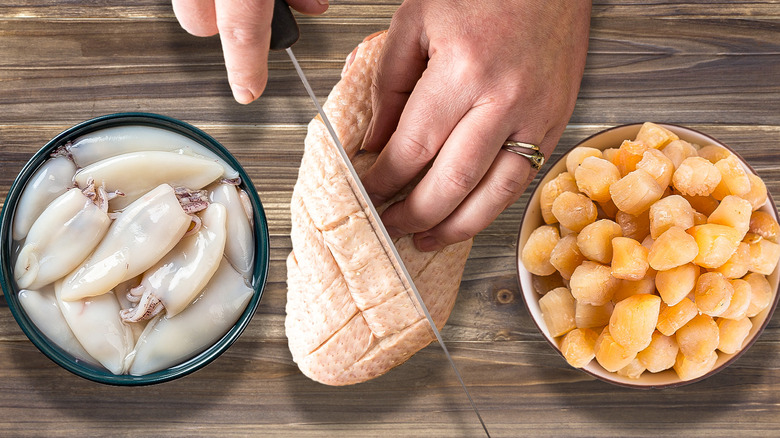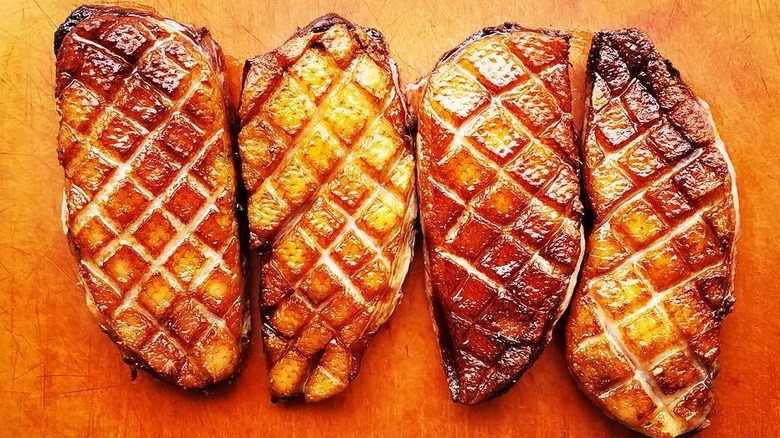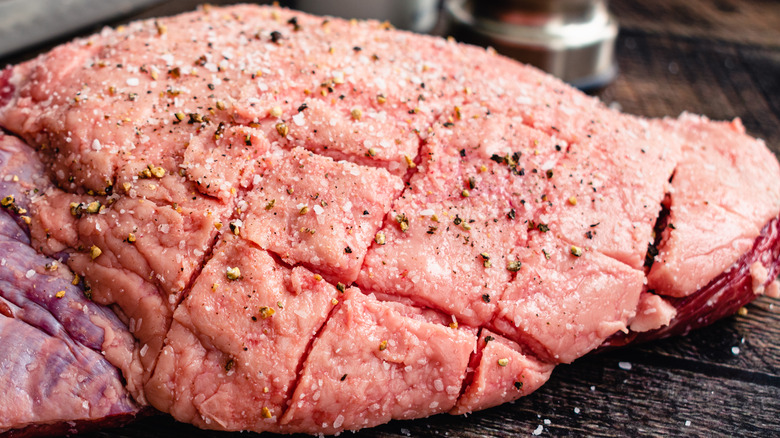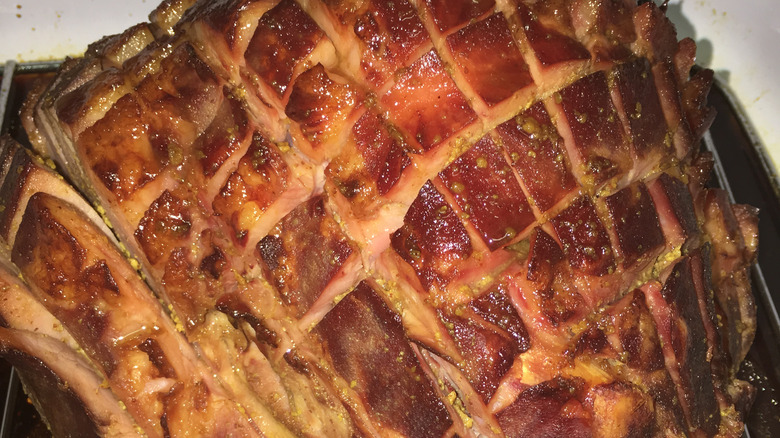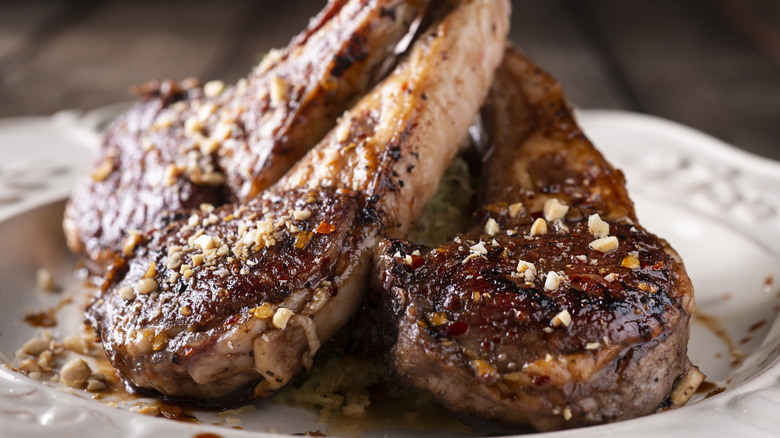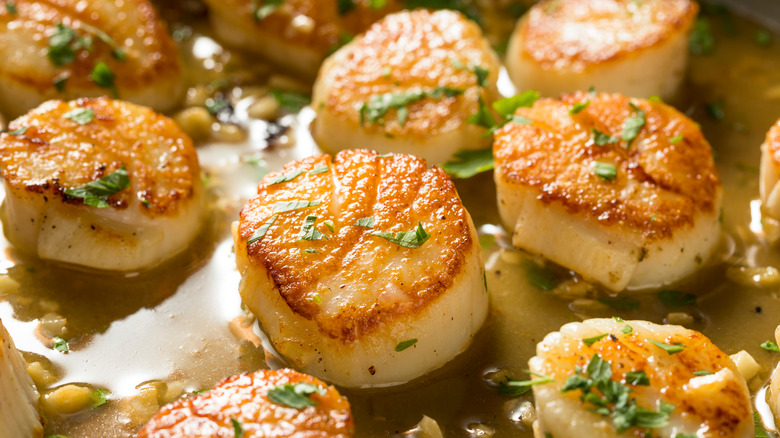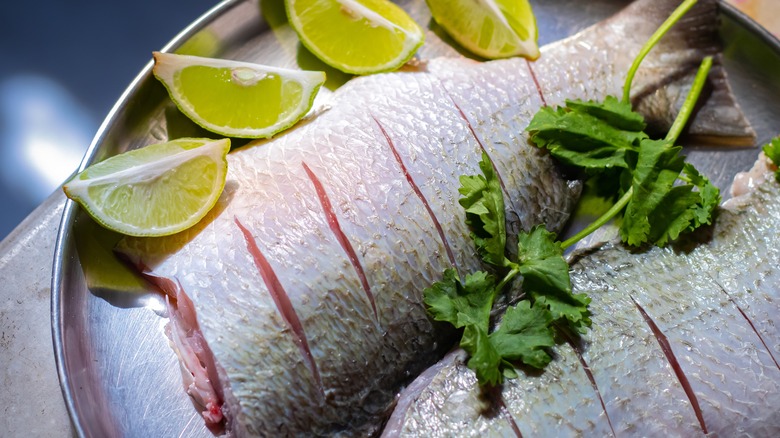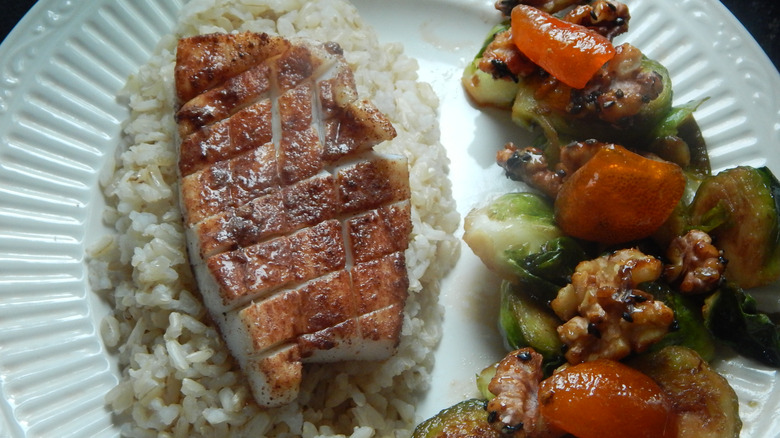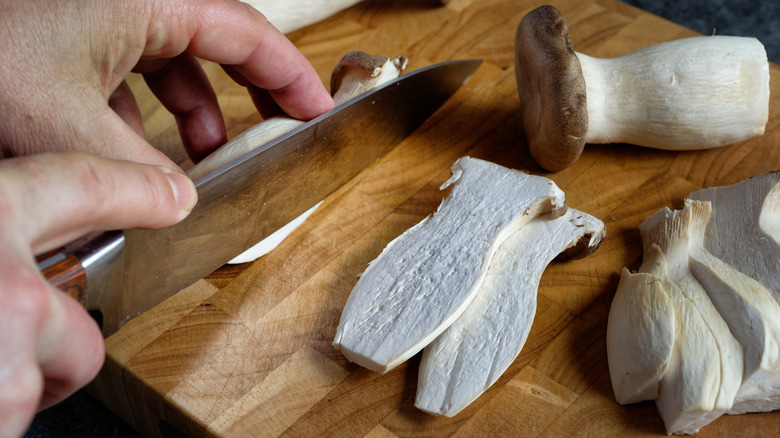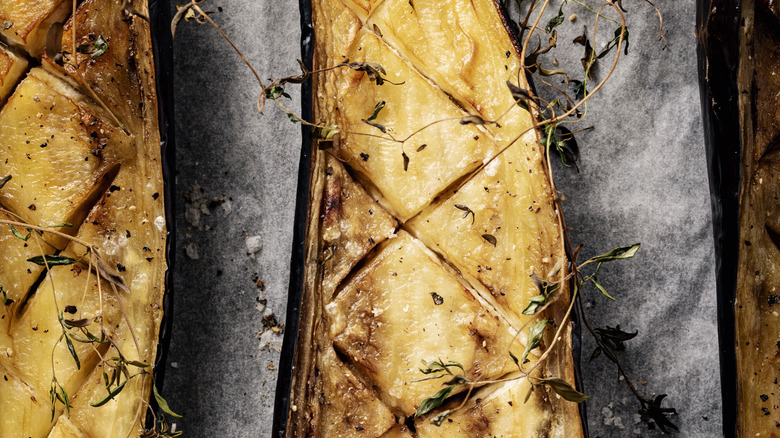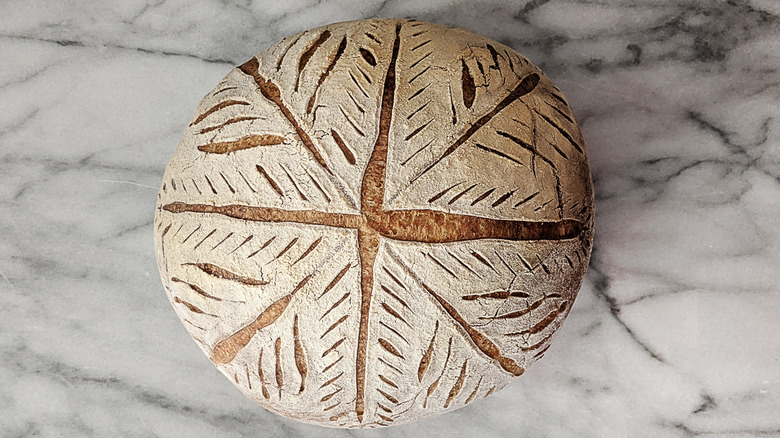11 Foods You Should Always Score Before Cooking, According To Chefs
Cooking is an art form. Different foods and ingredients take the place of paint and clay. Instead of brushes and canvases, culinary artists use knives and skillets to create their masterpiece meals. Nowhere is the artistic element of cooking more evident than when it comes to handling a knife. Rough chops, rondelle cuts, chiffonades, and julienne are just a few of the many different cuts that can be utilized with just a good sharp knife and a butcher's block or cutting board. Scoring, or using a knife to make shallow cuts or incisions on the surface of food, is another of these essential yet often underutilized techniques — especially when cooking at home.
To learn more about the fine art of scoring, we spoke with experts from some of the country's top cooking schools: the Institute of Culinary Education, the Cambridge School of Culinary Arts, and online cooking school Cozymeal. According to their instructors (who you'll soon learn more about), scoring food with tiny diamonds and cubes does more than just make food more beautiful. Scoring also improves the flavor of many foods. It can also help foods cook more effectively, reducing curling and improving searing and roasting. Scoring even makes certain foods easier to chew or present on the plate. Wondering which foods you prepare regularly that could benefit from some simple scoring before you put them on to cook? Read on for our experts' take on 11 foods you should always score during your pre-meal prep.
1. Duck
For most of us, duck is a special treat — something prepared for the holidays or an important family gathering. There are many ways to prepare duck, like roasted and crisped to perfection, seared, or even bathed in a delicate orange sauce. But whatever method you decide to use for your meal, your duck will generally benefit from some simple scoring before you put it on to cook.
According to Shawn Matijevich, lead chef-instructor of online culinary arts and food operations at the acclaimed Institute of Culinary Education, while chefs use scoring a lot, home cooks generally avoid it. This is especially true, Matijevich says, when it comes to preparing duck. Whether you're cooking duck breast, duck legs, or even an entire duck, this is one bird that's prized for having thick and fatty skin — a key part of its incredible flavor. Scoring the skin of the duck you're cooking before you expose it to heat helps that fat to render as the meat cooks, making it even more delicious.
"When you're cooking duck, the challenge is that you want to get crispy skin without overcooking the duck breast, and there's a layer of fat in between the skin and the meat," explains Christopher Diamond, a chef and instructor with the prestigious Cambridge School of Culinary Arts in Massachusetts. "So you score the skin to allow the fat to render out, and you cook it skin side down." The result? Even crispier and more mouthwatering roasted duck!
2. Ribeye or fatty steaks
When it comes to beef, the benefits of scoring are just as varied and delicious as the cuts of meat you might be cooking. For large, thick, fatty slabs of beef like ribeye or the incredible Brazilian favorite known as picanha, scoring is again a way to help render the fat out of the meat and make it even more tender, juicy, and flavorful. According to Matijevich, he's prone to scoring any type of beef that has a large fat cap, especially wonderful cuts like prime rib. That's because when you score the meat, more of that fat is exposed to the heat of cooking, and it renders and releases into the pan instead of staying trapped.
Lean, thinner cuts of beef like flank steak and skirt steak also benefit from scoring because those tiny cuts make the meat easier to chew after it has been cooked. And if you use a marinade on any of these meats, scoring serves another benefit as well — it helps that marinade to make your beef even more tender and flavorful.
"Marinating is really just surface flavoring," explains Matijevich. "But when you're making all these score marks on a piece of beef, you're drastically, exponentially increasing its surface area. So, theoretically, you can definitely improve the flavor concentration on any piece of marinated meat by scoring it first."
3. All types of pork
Pork is yet another savory and often fatty delicacy that can benefit from some simple scoring before you put it on to cook. Making pulled pork for a picnic or sandwiches before the big game? Score that pork shoulder and its fat cap in particular before you plop it into your slow cooker to brown and tenderize. Pork loin (especially cuts you plan on grilling or roasting), pork belly, and pork ribs will also all benefit from scoring before they're cooked, producing finished dishes that are not only more tender and juicy but also filled with the incredible, decadent flavor of rendered fat juices.
Chef Diamond explains that even a leaner pork chop can benefit from some simple scoring. For instance, if a large pork chop has a fat cap on just one side, he says he would likely score the fat to prevent the chop from curling as it cooks — a phenomenon caused by that silvery layer of elastin in the pork shrinking and "pulling" at the meat as it cooks.
4. Ham
With pork chops, pork shoulder, and pork belly, scoring serves a distinct purpose in improving the flavor or texture (or both) of the meat as it cooks. But there's another reason to score foods as well, and this one is especially prevalent with ham. Whether fresh, spiral cut, smoked, or dry-cured (the secret to German-style Black Forest ham), many hams are scored either by the manufacturer or by chefs or home cooks before they are put in the oven to roast and cook. And in this case, that scoring is purely decorative!
As an instructor to many soon-to-be high-level chefs, Matijevich tells us that scoring is often a technique many culinary professionals put to use to help make foods like ham look fancier or more presentable. In this case, the scoring doesn't help the food taste any better; instead, it is purely visual, he says. And it's something anyone can recreate at home to make their meals more like a fine dining experience.
5. Lamb or lamb shank
Few foods are more mouthwatering than a crispy, caramelized, beautifully seared leg of lamb. And lamb in all forms, from rich and tender lamb shoulder to juicy lamb chops to mild, delicate lamb ribs, can also benefit from scoring before it is put on to grill, roast, braise, or broil.
Just as scoring helps poultry, beef, and pork reach their maximum flavor potential, carving those diamonds in the skin, the fat cap and the exterior of any lamb is also excellent. Just don't be too aggressive with your knife when you take it to score your meat, regardless of whether you're cooking lamb or anything else.
"So when I'm scoring either a duck breast or a pork chop, I'm not interested in cutting into the meat at all," Chef Diamond tells us. The score marks should only slice into a portion of the fat or skin. So make sure your knife is nice and sharp, and then move with care and precision, being careful that your blade only scores the exterior of the lamb or anything else you might be cooking, and not the meat itself.
6. Scallops
Meat and poultry aren't the only forms of protein that are elevated through scoring. There are a number of different types of seafood that also benefit from having that grid-like pattern of thin parallel cuts carved into their surface before they are put on to cook. Sweet and buttery scallops are a prime example.
Loved for their delicate, briny flavor, scoring is an essential part of scallop preparation and cooking. The technique increases the surface area on the flat side of the scallop where the scores are made, helping heat to penetrate better and creating a better sear as the scallop cooks. That's important because a better sear equals more caramelization. In other words, scoring helps scallops to develop their wonderfully tasty, golden-brown crust — an essential element that makes these tiny shellfish so beguiling as a part of any meal.
7. Fish (especially thin filets)
Like scallops, many types of fish benefit from being scored during pre-meal preparation. You might score a whole fish, such as sea bass, branzino, or red snapper, to help the meat cook more evenly and reduce its cooking time. According to Diamond, scoring also has additional benefits when it comes to thinner pieces of fish such as salmon, trout, or snapper filets — it prevents curling. As Diamond tell us, when cooking fish with its skin on, the skin often starts to "tighten" and "shrink." This can cause the filet to curl and no longer lie flat. Scoring prevents that from happening.
As with meat, scoring fish should only be cut skin deep. Matijevich tells us that you can cut all the way through, but for the best results, try to only cut down as far as the skin. You can cut all the way through it, but you don't want to cut into the meat very far because then you're going to have another problem — the fish is going to cook a lot faster than you want it to, and it may dry out.
To score fish more easily and just cut the skin, Matijevich suggests holding the fish with one hand and curving it slightly upwards. By slicing into the now "rounded" area, you can make a shallower cut than if you were cutting the fish flat directly on a cutting board.
8. Calamari and squid
Beyond better searing, more even cooking, and a reduction in curling, there's one more very important reason to always score seafood like squid before you cook it — it will taste better. Whether you're making squid stir-fry or salad, grilled squid, or something else entirely, scoring makes the mild, slightly sweet squid easier to eat. "One reason you might score any type of food is to make something easier to chew," Matijevich says. When scoring squid, it also does more than just tenderize that meat. It also helps the squid cook faster and provides more surface area for caramelization, which is essential when you want to create that delicious golden-brown crust that makes many squid-based dishes so tasty.
But hold on! Before you score squid in particular, Matijevich suggests making sure your knife is as sharp as possible. A dull knife simply tears the meat apart, which doesn't improve the flavor or the way the squid cooks. It's not even or consistent, and the scores won't all be the same depth and the same thickness. If you're using a dull knife, then you're just going to wind up tearing your squid or other meat.
9. Large mushrooms (like King Oysters)
With their meaty texture and rich, savory, umami-packed flavor, mushrooms are a natural substitute for meat in many settings and entrees, from burgers and grilled steaks to stir-fries, pasta dishes, and more. So it only makes sense that these earthy delights — especially the really large, thick, and hearty ones — would also benefit from some scoring before being cooked.
Whether you're grilling, sautéing, or roasting mushrooms, scoring is a simple yet effective technique to help improve their texture, flavor, and presentation on the plate, says Matijevich. Scoring helps with browning, he explains. Mushrooms are also known for their high water content. Scoring helps to remove that liquid. When you score a large mushroom cap or a thick slice of mushroom stem, it creates more surface area that can come into contact with the hot pan. This helps the trapped moisture from within the mushroom to escape and gives the mushroom a more meaty, caramelized flavor as it sears and cooks.
When it comes to your searing technique, Matijevich suggests letting the size of the mushroom determine the size of your score. For a small oyster mushroom, that might mean allowing about a quarter of an inch between each score mark. For a massive portobello, however, that distance might expand to about half an inch. Scores should be proportional to the size of the ingredient that you're prepping, he says.
10. Thick and water-packed veggies like zucchini and eggplant
Beyond mushrooms, many other large and savory veggies — especially those that contain a lot of water — will benefit from being scored before they are cooked. This includes potatoes, bell peppers, squash, and more.
Eggplant definitely comes to mind as a vegetable that benefits from scoring, says Beacco. Let's say you want to cook eggplant not only more evenly but also distribute seasoning. You can slice the eggplant in half and score its interior in a checker pattern, he explains. This is a great way to prep eggplant before you grill it, stuff it, or use it to make eggplant pizza or an eggplant-based curry. It improves not only the flavor of the veggie — more spice and flavor and caramelization will develop throughout — but also helps the eggplant to cook more quickly as well.
Zucchini and other types of squash are also ideal for scoring before you put them on to cook, says Matijevich. When you score the surface, you allow more of that vegetable to kind of twist and turn as it cooks. In other words, while your farm fresh veggie looks like it is lying flat in the pan, you actually have a beautiful network of cuts, raised edges, and score marks all coming into contact with the skillet's uber-hot surface. Each one of these cuts and scores can then sear and caramelize individually, helping to release water (as steam) from the produce and cook even more deliciously.
11. Puff pastry desserts and breads like sourdough
Scoring isn't for savory cooking alone. Many baked goods benefit from some good scoring as they cook as well. Scoring is often used with many puff pastry-based desserts, including tarts, turnovers, and hand pies. In all these cases, scoring improves the puff pastry's ability to rise and prevents air pockets from ballooning up as the desserts cook, explains Chef Beacco. You make your scores right before the dessert goes in the oven. This prevents bubbling and uneven cracking on the crust while promoting perfect browning.
According to Matijevich, you should also consider scoring starchy, yeasty bread that will rise a lot in the oven as it bakes. This includes loaves like sourdough, French baguettes, or crusty Italian breads.
For these baked delights, scoring improves the quality of your final baked loaf. If the bread is too compressed in the pan or if its crust forms too early as it bakes, then the loaf itself has nowhere to grow or expand, making it dense and doughy. By scoring bread before it starts to cook, you create additional space in the crust that allows it to open fully and become as crumbly and fluffy as possible!
While you could use a very sharp knife to score your loaf before baking, consider investing in a "lame" (pronounced lah-may). This long, thin, razor-sharp blade is attached to a handle and designed to make precise cuts in bread dough before baking.
